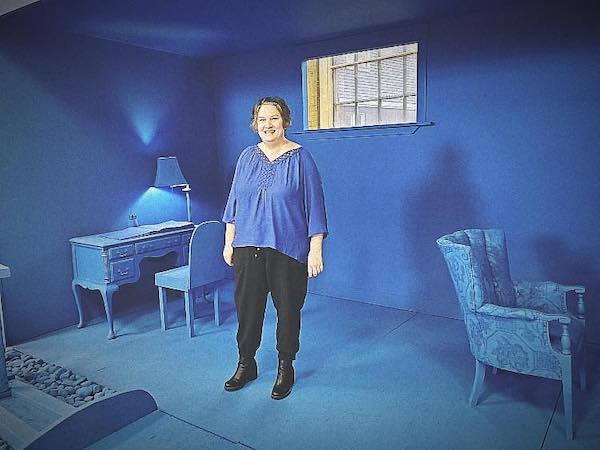
I have a deep admiration for the work of Amy Stacey Curtis, an installation artist who lives in Lyman, Maine. One year ago, Amy wrote a guest post for me about a debilitating neurological illness that overtook her brain and her life (as well as her husband Bill’s life) for nearly two years. Her symptoms began abruptly in 2017 shortly after she had wrapped up an intensive 18-year-long project.
It took 15 months to figure out that Amy’s brain was being attacked by untreated Lyme Disease. I’ll include the link to her essay about her experience at the end of this post, but right now I’d like to focus on her current exhibit., which is called The Color of Memory. I, and countless others have been inspired by her creativity since long before her illness, but even more so now, considering what she has endured.
I walked through and participated in (because that is what she always encourages us to do) her new exhibit this past weekend, and then interviewed her about her process. How does she come up with and then execute her ideas? Here’s what I learned.
memoir I
Beginning in 1998, every other year Amy presented an interactive exhibit in a vast open space in one of Maine’s historic mills. In all she mounted 81 installations that invited people to participate in some way.
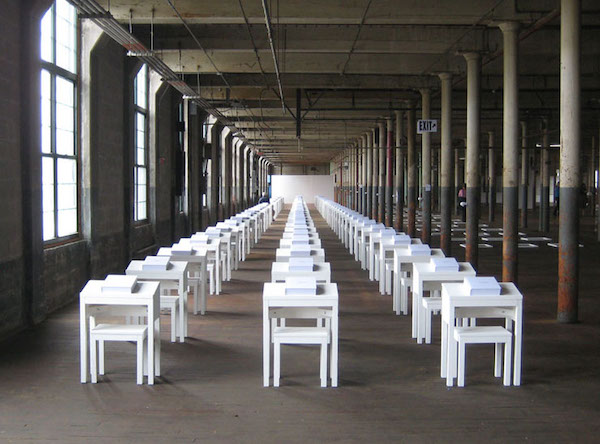
Courtesy Amy Stacey Curtis
Her ninth and final exhibit, in the Bates Mill in Lewiston, was called Memory. One of the installations, memoir I, consisted of 99 desks and stools, 99 books, and 99 pencils, all painted white. The books spanned 99 years, from 1918 to 2016. Participants were invited to write a memory that occurred within the year printed on the book’s cover. One memory, one book, up to nine memories total.
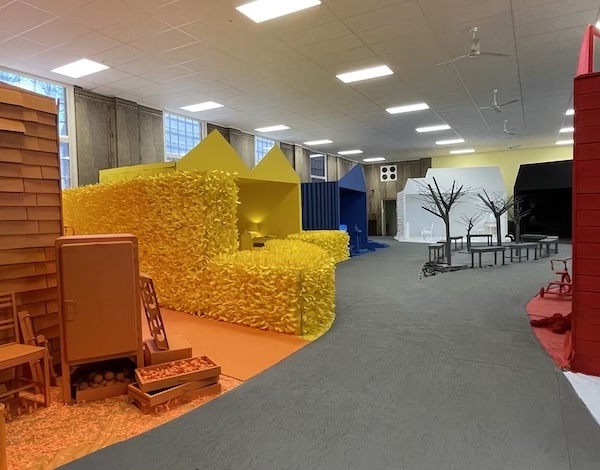
The Color of Memory
Amy is currently the artist-in-residence at The University of Southern Maine, and recently opened her exhibit The Color of Memory, which she also refers to as memoir II. When you walk through the doors of what was once the gymnasium in the old Westbrook High School on the corner of Main and Foster Streets, you enter a colorful neighborhood of what Amy calls enterable spaces. Within each space, she invites us to explore our memories.
My idea for memoir II was to create nine enterable spaces, each painted one of the nine colors that I’ve explored since 2003 — black, white, red, yellow, blue, orange, green, light blue, and light pink.
Amy Stacey Curtis, artist
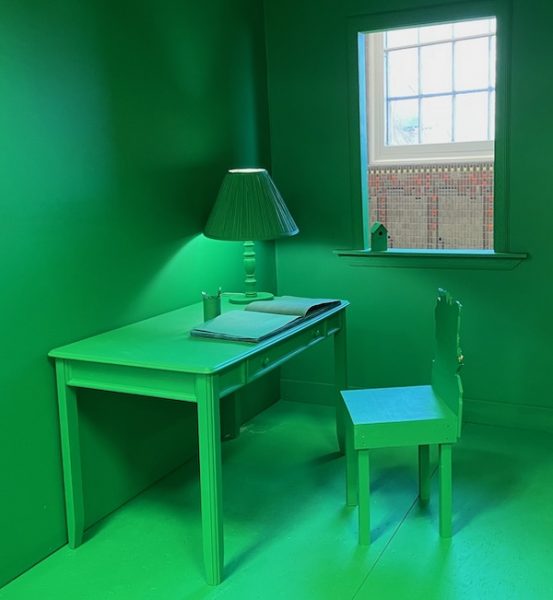
I’d have a book in each space, a desk, a chair, and a pencil. And I’d ask each participant to write a memory in each respective book that was sparked by the color of that space.

For instance, if you are in the red space, what memory from the moment you were born to the present time comes comes first in your mind, or comes to mind when you think about that color or you’re surrounded by that color?
Artistic process
Amy’s ideas for her exhibits always begin with her thesaurus.
I read my thesaurus every other year as a basis for all of my ideas. Sometimes a word will spark a whole idea immediately or I’ll be intrigued by a word and definition that I’ve come upon and it’ll sit in my brain for a while. I might be doing dishes or vacuuming, and then the idea will come to me.
Because it was the theme of her final biennial exhibit, memory was on her brain as she started thinking about her current exhibit.
I was especially interested in words that that had to do with memory, such as memoir and ancestry and reflection. There are all kinds of words that are sparked from that impact impression. So, that’s how I came to this concept.

Ultimately, the space she will be working in determines how she will present her concept and what it will look like. In this case, she is once again exhibiting in an historic space. Built in 1886, the building was once the city’s high school, and then the junior high school until the mid-70s. For many years after, the gymnasium was headquarters for the Westbrook Rec Department. The entire building was eventually rehabbed and converted into senior housing, and the gymnasium floor was fully carpeted. Amy had to figure out how to create and place her nine spaces without damaging the carpet.
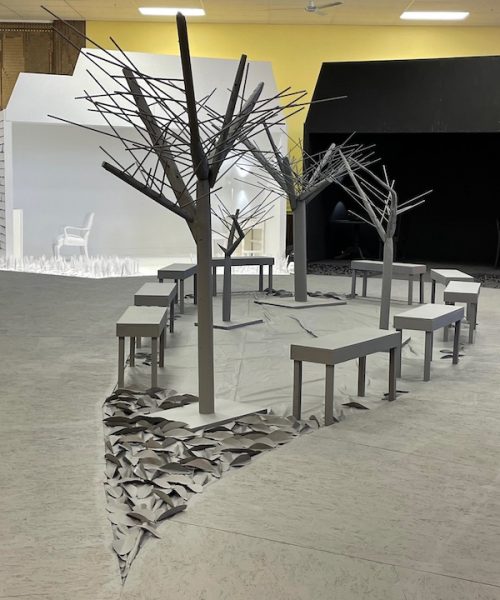
It really didn’t make sense to just build nine cube spaces and put them on the rug. It wouldn’t work aesthetically, so it developed into more of a neighborhood with houses and a boardwalk. All because I had to protect a rug. I created a boardwalk, which became like a cul-de-sac, and then the spaces, nine spaces became houses around this cul-de-sac. And then I thought it’d be boring if all the houses were exactly the same, even though they were each going to be a different color, so they all have different roof lines. I didn’t want to give them all the same kind of yards, so they all have different aesthetics and personality and characters, and then all this character development just started to blossom from that.
When I walked through the exhibit a second time I realized that I had missed some of those relationships. Amy also filled in some of the back stories about the spaces.

This house was inspired by a women whose husband had passed away six years ago. He’d been a hoarder and she invited Amy to go through his things to see if there was anything she could use for her exhibit. There was and the result is the orange house, filled with a multitude of things, all painted orange. I read in another article about the exhibit that Amy loves the repetitive process of painting objects.

Not everyone appreciates a clutter of objects of any color, and so that led to the yellow house next door.
I figured I wouldn’t be surprised if the people in the yellow house didn’t want to look at the orange house’s stuff. They have these really tall hedges between the two properties so that they don’t have to look at their stuff. They also have hedges in front but those are shorter because even though they’re isolationists they want to know what’s going on.
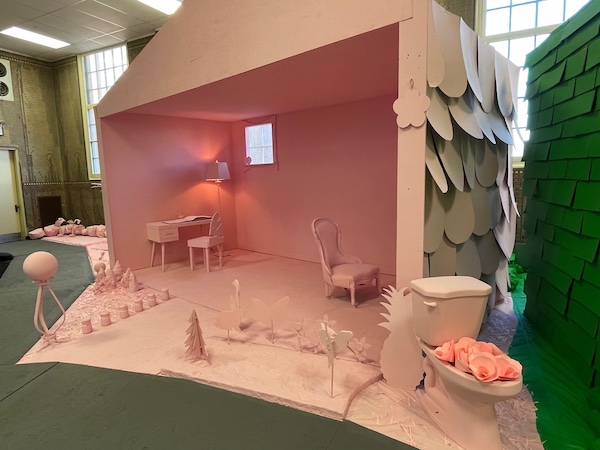
In the pink house, the “inhabitants” love lawn ornaments, including a pink toilet filled with pink paper flowers.
If you’ve ever noticed lawn ornament laden houses, it’s a common thing to have a toilet with a garden planted in it and pink flamingos and the glass ball and the gnomes, so I wanted to recreate that. I thought of different extremes that I could do that would really stand out.
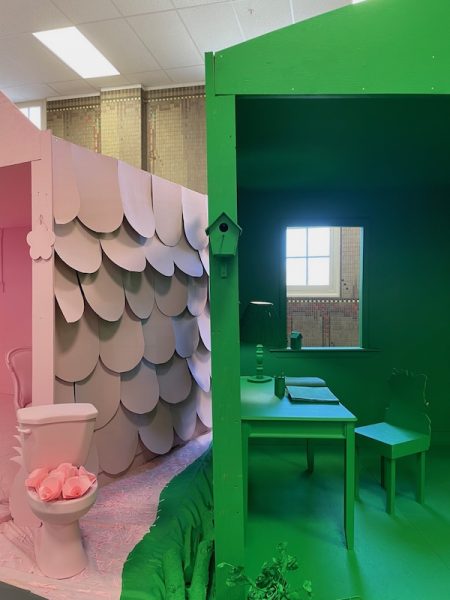
The green house next door was inspired by her mother and father-in-law’s home.
It’s a very New England country aesthetic, where they have mulch and little plants in their places in flower pots and stars and a fence. Very decorative.
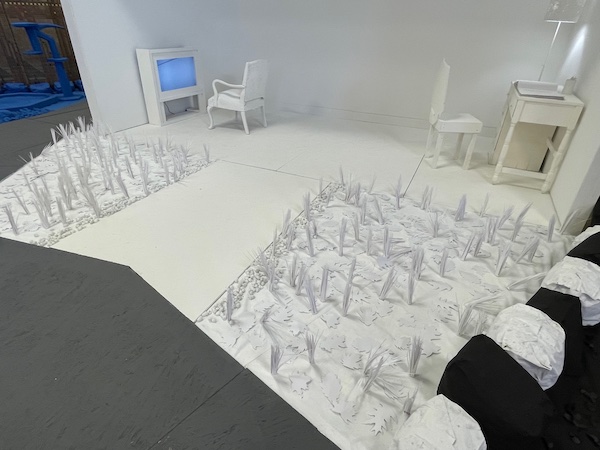
The white house is kind of a self portrait.
Where I’m recovering from a brain injury, our house has grass that hasn’t been mowed in a long time and leaves that don’t get raked and acorns that have fallen. So that house is very inspired by what our house is kind of like right now.
Amy says she hasn’t processed whether or not there’s an overall connection between her health issues and the exhibit, but that she’s mostly intrigued by the idea of memoir and making a place for people to share their memories. She plans to publish what people wrote in an anthology.
There’ll be nine books that I’ll eventually publish around this particular piece, and each house will have its own book. There’ll be the red book and the orange book and the green book and so on. Each will be an anthology of memories that were collected from the houses.
Based on what they’ve written in the books, it’s clear that everyone connects to the houses and the colors in their own way.
A few people have commented that there are certain colors that seem to be sparking painful memories and some that seem to be sparking more positive memories. it’s interesting.
It isn’t just the colors and the houses that are sparking memories. So, too, is the space, in general. A lot of people have come in and said they went to high school or junior high school here. In fact, my father’s family hails from Westbrook, and I am certain he and his four brothers attended school here, and several of them no doubt played basketball on the original uncarpeted floor. When you think about it, we are all enveloped by our memories, good, bad, indifferent. They are part of us. Thank you for yet another wonderful and thoughtful exhibit, Amy.
Exhibit information
Amy’s exhibit will be open for participation for ages 7 and up through April 22, 2022 at 22 Foster Street in Westbrook, Maine, 10 am to 5pm every day. If you can’t visit in person, she is also doing virtual interactive presentations. You’ll find more information about that on her Facebook page.
Here’s the link to Amy’s Catching Health essay from a year ago: Taking back my brain: How Amy survived suicidal psychosis and neurological disorder

Leave A Comment